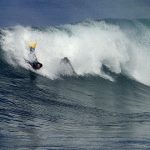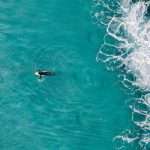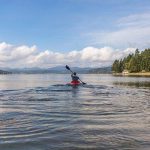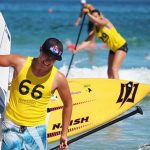If you’re looking for a fun activity the whole family can enjoy, consider bodyboarding. Whether you want a beginner board for slow-breaking waves in shallow water or a higher-performance board for catching big waves, we can help you find the perfect board.
How to Choose a Bodyboard?
Overwhelmed by the many bodyboard options on the market?
This buyer’s guide will help you choose the right board whether you’re a beginner or an experienced bodyboarder.
What size Bodyboard do I need?
We hear this question a lot at Boardshop when people are trying to pick out their first Bodyboard.
The rule of thumb for finding the right sized bodyboard is that it should reach your belly button when standing on the floor.
Another way to size your board is to make sure that it reaches from your knees to your chin when held out in front of you. The same rule applies when sizing a bodyboard for a child.
Other things to consider
- Small Wave Bodyboarding: If you intend to mainly Bellyboard in white water, with small and slow-breaking waves then we recommend getting a Body Board slightly taller than the height of your belly button. If you are larger, we recommend going slightly wider too as extra buoyancy is beneficial on smaller days.
- Big Wave Bodyboarding: If you are Bodyboarding in the bigger, faster, and more powerful waves out back, you should opt for a slightly smaller Body Board as this will allow you to be more agile and in control of the board.
- Riding Style: If you want to try some less traditional methods of Bodyboarding such as drop-knee or stand-up Body Boarding you should look for a Bodyboard with a bit more length.
Which Bodyboard Should I Purchase Based on my Ability?
The chart below shows you which construction board to use and what accessories to get based on your ability level.
Beginners & Children’s Bodyboards
When you start a new sport, it is important to get gear that is appropriate for your skill level. If you get gear that is too difficult, it can make it hard to improve and enjoy the sport.
If you are a beginner Bodyboarder, we would recommend purchasing a board with the following features:
EPS (Expanded Polystyrene) Core
The cores of the EPS boards are perfectly resilient for beginners,floaty, and lightweight. The foam is also soft, making the board very comfortable and helping to avoid irritation on the hips, arms, and elbows.
HDPE (high-density polyethylene) Slicks
If you’re a beginner, you’ll want to choose a durable option like these slicks. They offer maximum speed on smaller and broken waves, which makes them perfect for learning.
XPE / IXPE (cross-linked PE foam) deck
Decks that are durable and water-resistant are perfect for beginners and kids. These decks are less likely to be damaged while the user is still learning how to skateboard.
Single Stringer
A beginner bodyboarder only needs one stringer for a good balance of rigidity when paddling and flexing on the wave.
Tail
The two main types of tails for beginner kiteboarders are bat tails and crescent tails. These tails help with performance when doing tricks. The differences between these two tail shapes will not be noticeable for beginners.
Accessories
It is also a good idea to buy a leash so you do not lose your board while surfing.
Other accessories are not necessary for a learner starting, but if you enjoy the sport and feel like you want to spend more time bodyboarding, it will be worth investing in wax, swim fins, and a good quality bodyboard bag.
Intermediate to Advanced Bodyboards
If you have been bodyboarding for a while and have decided that you enjoy it, we recommend buying a better board to help you improve your skills and perform tricks.
If you are an Intermediate to Advanced Bodyboarder, we would recommend purchasing a board with the following features:
PE (Polyethylene), PP (Polypropylene), or Dual (3D) Cores
For cold water bodyboarders, a PE core would be recommended, and for warm water bodyboarders, a PP core would be recommended.
It is recommended that you purchase a board with dual cores, as this will give you the best combination of both performance and durability.
Surlyn Slicks
A top-quality Surlyn coating on the deck of your board will make it more responsive and flexible than cheaper boards coated with HDPE.
The Surlyn coating will increase the speed of your board, propelling you through the wave, and the elasticity of the material will allow the board to flex easily to the shape of a wave.
PE (Polyethylene) deck
Polyethylene decks are softer and more flexible than their crosslinked polyethylene counterparts, which improves the bodyboard’s turning ability.
Two or More Stringers
Adding stringers to your board will make it last longer, help it keep its shape, and improve performance. Drop knee riders often prefer boards with 2 stringers.
Tail
The crescent-shaped tail board is recommended for those who want to try the drop knee riding style. The Bat Tail shape is particularly popular with prone riders who regularly perform tricks, as this shape gives the board more contact with the face of the wave.
Accessories
Bodyboarding wax is used to help you grip your board and keep you from slipping. It also helps to protect your board from the sun and salt water. Swim fins help you move through the water more easily and give you more control over your bodyboard.
A good-quality bodyboard bag will protect your board from damage when you are not using it.
A good quality wax will provide additional grip to your board when riding larger and faster waves. Swim fins will give you the extra speed and power needed to propel yourself through a wave and paddle out on big days.
A good quality bodyboard bag will protect your board and allow you to travel with your board to wherever the conditions look the best!
Bodyboarding for Beginners: How to Boogie Board with Kids
Kids can play and ‘surf’ on the edge of the water to have some fun.
. It’s more enjoyable for everyone involved when kids are a little older before trying to boogie board. This is typically around the age of 6 or when they can swim well on their own. To help teach them, here are a few tips.
- Look for a place where the waves are large enough to ride – but not overwhelmingly big.
- Spend some time on the beach watching the waves (and hopefully other boogie board riders who are already out there.)
- Being able to identify good waves to catch is just as important as actually riding them; when teaching kids to boogie board the parents can help with this. For adult boogie boarder beginners it pays to watch others and learn.
- Wade out into the water until it reaches the height of your waist – usually this is the “whitewash” where the waves have broken. Tow the child around on the boogie board so they can get a feel for the board and the motion of the sea.
- Next, talk about how you are then going to tip them off – or flip it. This is important because if you’ve never fallen off a boogie board you won’t realize that it’s quite a shock. Getting them used to falling off the board desensitizes them to this. It reduces the risk of future panic attacks that could happen when they are in the surf and fall off – or hit a wave at the wrong angle and get flipped over.
- if you are an adult beginner, Watch the waves breaking and see if you can get a sense of the movement of the ocean.
- Make sure the child has a good grip on the board and is centered (but this will also come with practice.
- Line yourself up exactly where the waves are breaking and when the time is right, push the kid onto the crest of the wave. The extra push from you helps them get the timing right, helping them to catch waves unaided in the future. This parental involvement in the early stages is vital
- Once they have caught a few waves or got a sense of how the ocean moves, talk again about being centered and also raise your chest, which gives you a bit more speed.
- Finally, don’t forget to take a look at their faces the first time they catch a wave – that expression is PRICELESS!
I realize that these boogie boarding tips are for kids, but I think the same steps should be followed for adult beginners.
Two more bodyboarding for beginners tips:
- Don’t forget to attach your leash
- A wetsuit is vital in most places, as you can get cold very quickly.
How do a Boogie Board and a Surfboard Compare?
Many people enjoy both surfing and bodyboarding, but it is tough to say which one is better. They are both great ways to enjoy the water, and each one has its own unique appeal.
Surfing is often seen as the more challenging of the two, while bodyboarding is considered to be a bit more relaxed. Ultimately, it all comes down to personal preference and what you are looking for in a water sport.
The following text is about surfing on a longer board. You have to stand up to ride the wave at just the right time, which takes some practice and good balance.
A short phrase to describe the text would be “The benefits of surfing.”
Although surfing is more difficult than bodyboarding, it can be more fun once you get the hang of it. Beach boogie boards can help beginners learn faster and have fun at the same time.
Surfboards are usually heavier than bodyboards, so kids may not be able to use them as easily. You also have to wax surfboards more often.
A boogie board can be a great introduction to surfing for those who may become interested in the sport later on. Bodyboarding is also a lot of fun and can be done at the same time as surfing.
Both activities are a great way for the family to spend time together.
What Other Items Might you Need when Bodyboarding?
Other items you may wish to consider for your water activities include a rash vest and a wetsuit. The type of wetsuit you may need depends on the climate. Wetsuits are available in short versions for warmer water, as well as summer and winter variants.
If you’re worried about your skin getting sore or chafed, you can wear a rash vest. You can wear it by itself or under a wetsuit as an extra layer of protection.
If the beach has pebbles or rocks, or if there’s a chance of getting stung or bitten by wildlife, wearing wetsuit shoes can also be helpful.
If the bodyboard is used often or stored in a dusty area, a specially made bag may also be useful. Some people also like to wax their boogie board, though even for adults this isn’t really needed.
Other Useful Features to Look for
Leash
Bodyboards usually come with a leash that has a strap that attaches around the wrist with velcro. The leash prevents kids from being separated from their board when they flip over or fall off. Instead of floating away, the board stays in the water nearby so they can easily grab it again.
All the products we feature include a leash.
Rails
Some boogie boards for kids have handles on either side near the head, which can make it easier to grip the board and less likely for it to slip away.
However, handles are not necessary, and many boards have grooves or raised edges along the sides for improved grip. Handles can make the board more difficult to carry.
Fins
Some boards come with fins attached, which can improve the experience, but they are not necessary for kids or beginners.



